MBA Project: Scope, Stakeholder Management & Risk Mitigation Analysis
VerifiedAdded on 2023/06/10
|32
|2955
|420
Project
AI Summary
This project assignment provides a comprehensive analysis of project scope, stakeholder management, and risk mitigation strategies. It begins by defining project scope, its aims, and objectives, emphasizing the importance of planning, control, and closure. The assignment then delves into stakeholder analysis, outlining the process of identifying stakeholders, assessing their significance and influence, and defining their participation. Key aspects of stakeholder management, including communication, expectation management, and relationship building, are discussed, along with the major inputs and tools for creating an effective stakeholder management plan. Finally, the assignment addresses risk analysis and mitigation strategies, highlighting the importance of acknowledging risks, developing plans to avert repercussions, and maintaining stakeholder awareness. The document is contributed by a student and available on Desklib, a platform offering solved assignments and study resources for students.

Paraphrase This Document
Need a fresh take? Get an instant paraphrase of this document with our AI Paraphraser
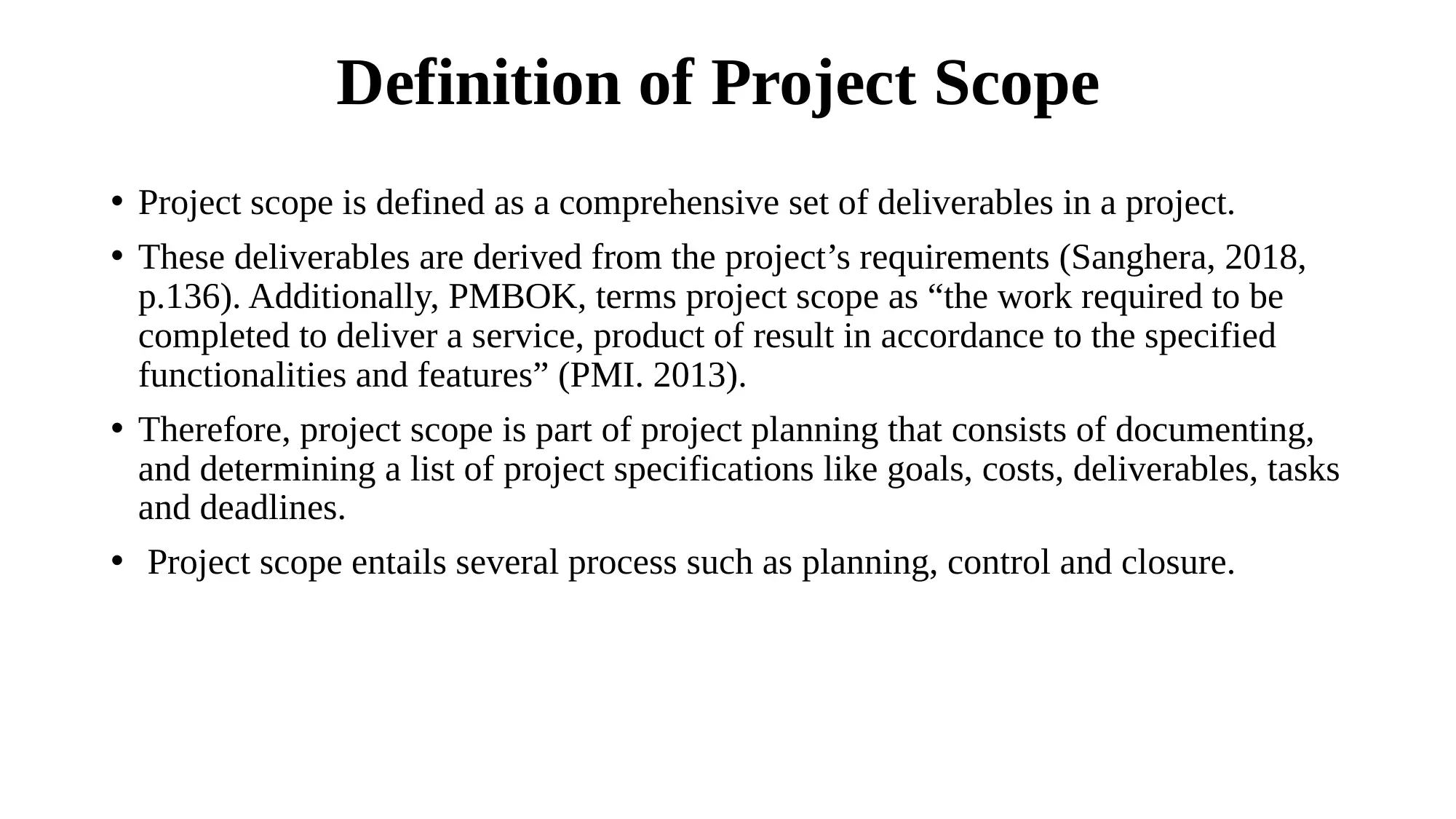
Definition of Project Scope
• Project scope is defined as a comprehensive set of deliverables in a project.
• These deliverables are derived from the project’s requirements (Sanghera, 2018,
p.136). Additionally, PMBOK, terms project scope as “the work required to be
completed to deliver a service, product of result in accordance to the specified
functionalities and features” (PMI. 2013).
• Therefore, project scope is part of project planning that consists of documenting,
and determining a list of project specifications like goals, costs, deliverables, tasks
and deadlines.
• Project scope entails several process such as planning, control and closure.
• Project scope is defined as a comprehensive set of deliverables in a project.
• These deliverables are derived from the project’s requirements (Sanghera, 2018,
p.136). Additionally, PMBOK, terms project scope as “the work required to be
completed to deliver a service, product of result in accordance to the specified
functionalities and features” (PMI. 2013).
• Therefore, project scope is part of project planning that consists of documenting,
and determining a list of project specifications like goals, costs, deliverables, tasks
and deadlines.
• Project scope entails several process such as planning, control and closure.
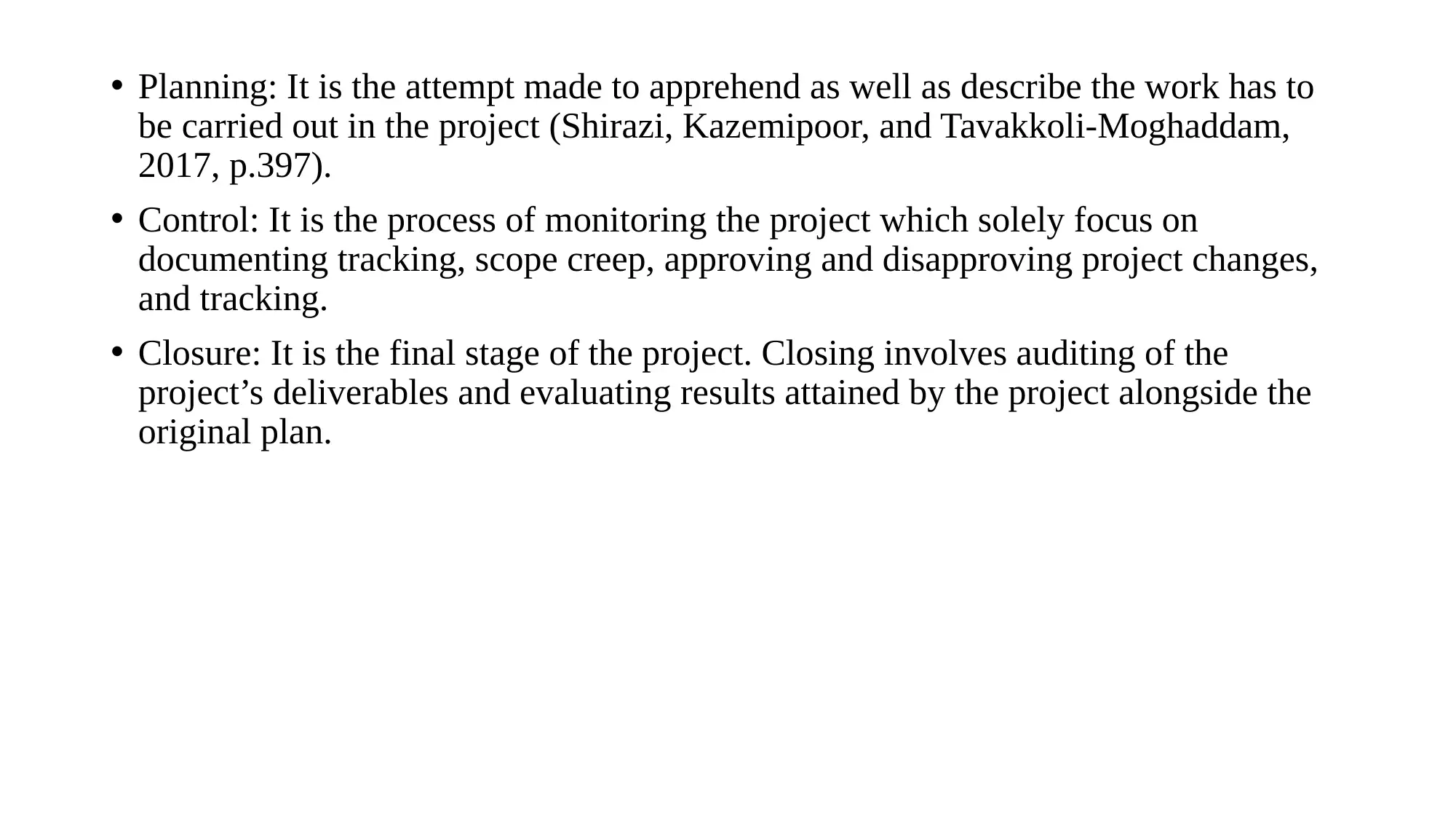
• Planning: It is the attempt made to apprehend as well as describe the work has to
be carried out in the project (Shirazi, Kazemipoor, and Tavakkoli-Moghaddam,
2017, p.397).
• Control: It is the process of monitoring the project which solely focus on
documenting tracking, scope creep, approving and disapproving project changes,
and tracking.
• Closure: It is the final stage of the project. Closing involves auditing of the
project’s deliverables and evaluating results attained by the project alongside the
original plan.
be carried out in the project (Shirazi, Kazemipoor, and Tavakkoli-Moghaddam,
2017, p.397).
• Control: It is the process of monitoring the project which solely focus on
documenting tracking, scope creep, approving and disapproving project changes,
and tracking.
• Closure: It is the final stage of the project. Closing involves auditing of the
project’s deliverables and evaluating results attained by the project alongside the
original plan.
⊘ This is a preview!⊘
Do you want full access?
Subscribe today to unlock all pages.

Trusted by 1+ million students worldwide
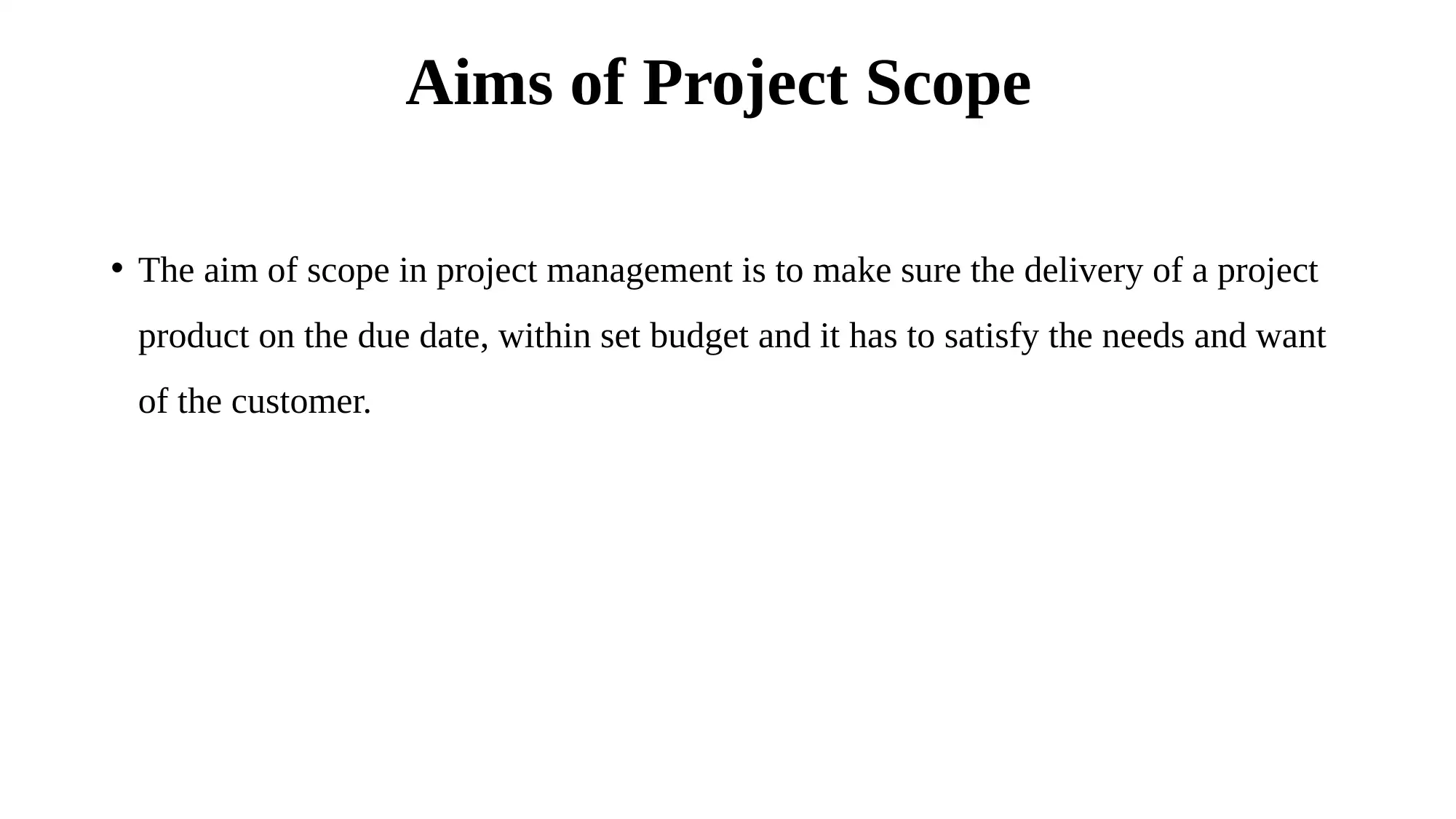
Aims of Project Scope
• The aim of scope in project management is to make sure the delivery of a project
product on the due date, within set budget and it has to satisfy the needs and want
of the customer.
• The aim of scope in project management is to make sure the delivery of a project
product on the due date, within set budget and it has to satisfy the needs and want
of the customer.
Paraphrase This Document
Need a fresh take? Get an instant paraphrase of this document with our AI Paraphraser
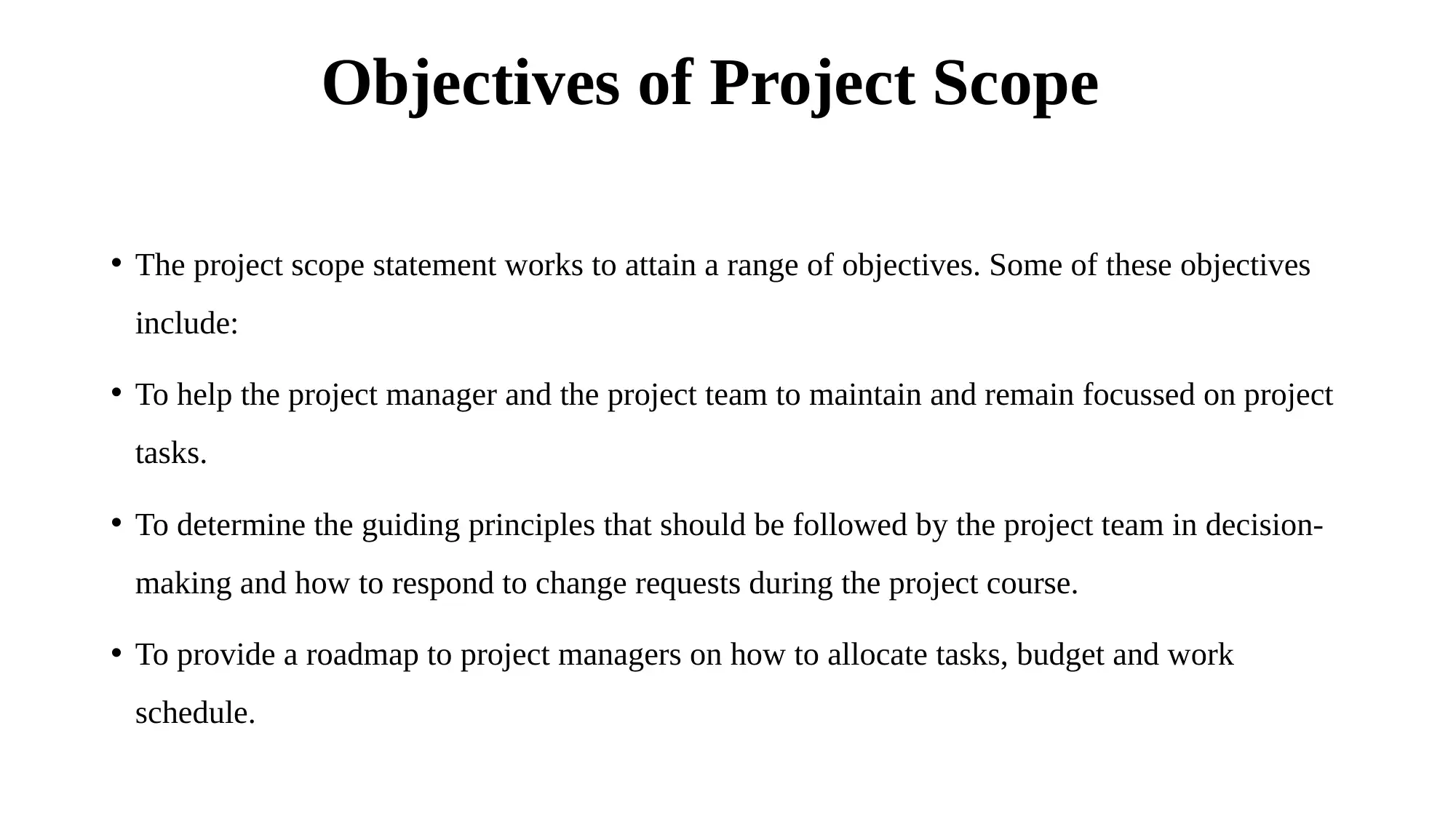
Objectives of Project Scope
• The project scope statement works to attain a range of objectives. Some of these objectives
include:
• To help the project manager and the project team to maintain and remain focussed on project
tasks.
• To determine the guiding principles that should be followed by the project team in decision-
making and how to respond to change requests during the project course.
• To provide a roadmap to project managers on how to allocate tasks, budget and work
schedule.
• The project scope statement works to attain a range of objectives. Some of these objectives
include:
• To help the project manager and the project team to maintain and remain focussed on project
tasks.
• To determine the guiding principles that should be followed by the project team in decision-
making and how to respond to change requests during the project course.
• To provide a roadmap to project managers on how to allocate tasks, budget and work
schedule.
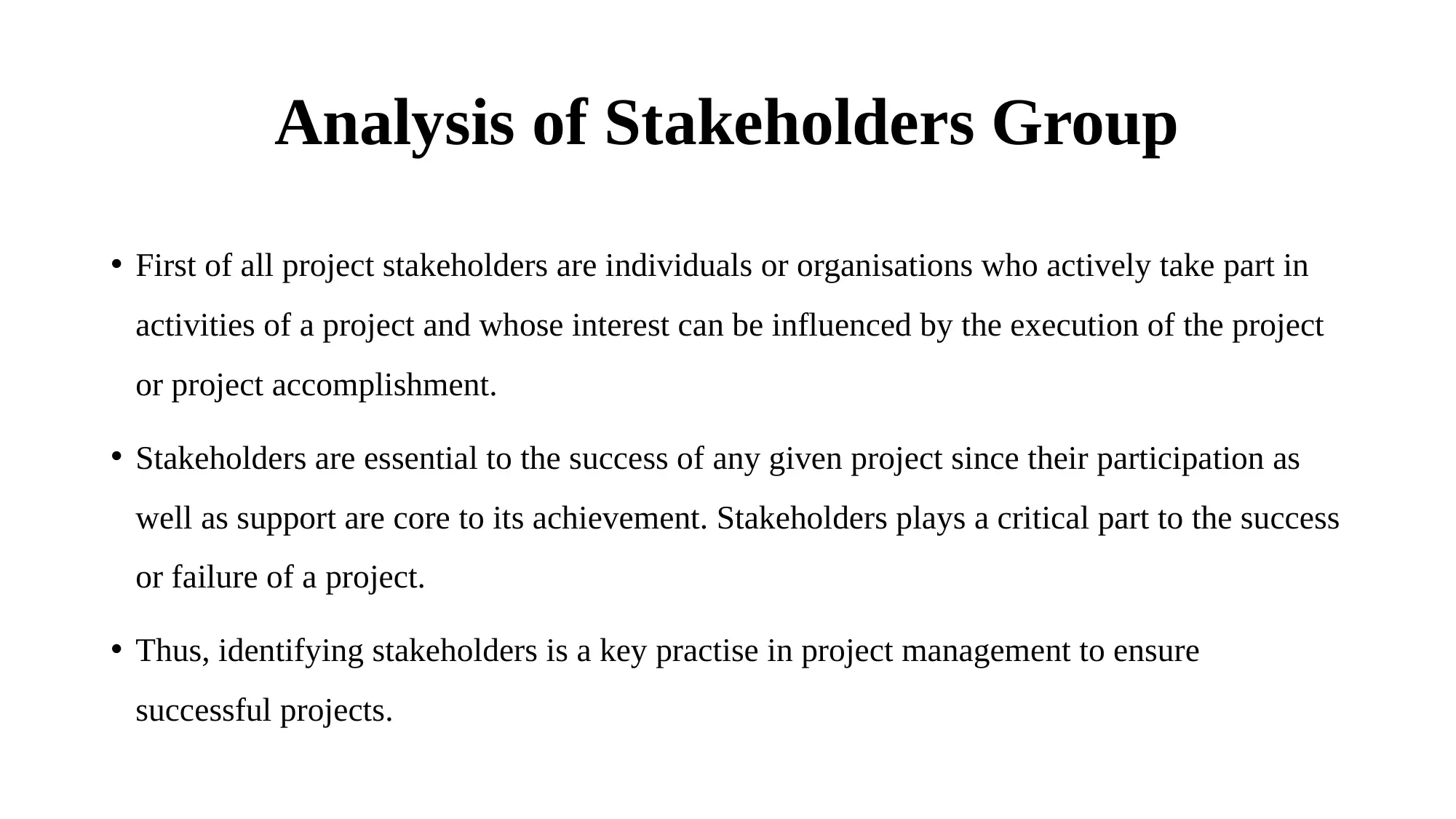
Analysis of Stakeholders Group
• First of all project stakeholders are individuals or organisations who actively take part in
activities of a project and whose interest can be influenced by the execution of the project
or project accomplishment.
• Stakeholders are essential to the success of any given project since their participation as
well as support are core to its achievement. Stakeholders plays a critical part to the success
or failure of a project.
• Thus, identifying stakeholders is a key practise in project management to ensure
successful projects.
• First of all project stakeholders are individuals or organisations who actively take part in
activities of a project and whose interest can be influenced by the execution of the project
or project accomplishment.
• Stakeholders are essential to the success of any given project since their participation as
well as support are core to its achievement. Stakeholders plays a critical part to the success
or failure of a project.
• Thus, identifying stakeholders is a key practise in project management to ensure
successful projects.
⊘ This is a preview!⊘
Do you want full access?
Subscribe today to unlock all pages.

Trusted by 1+ million students worldwide
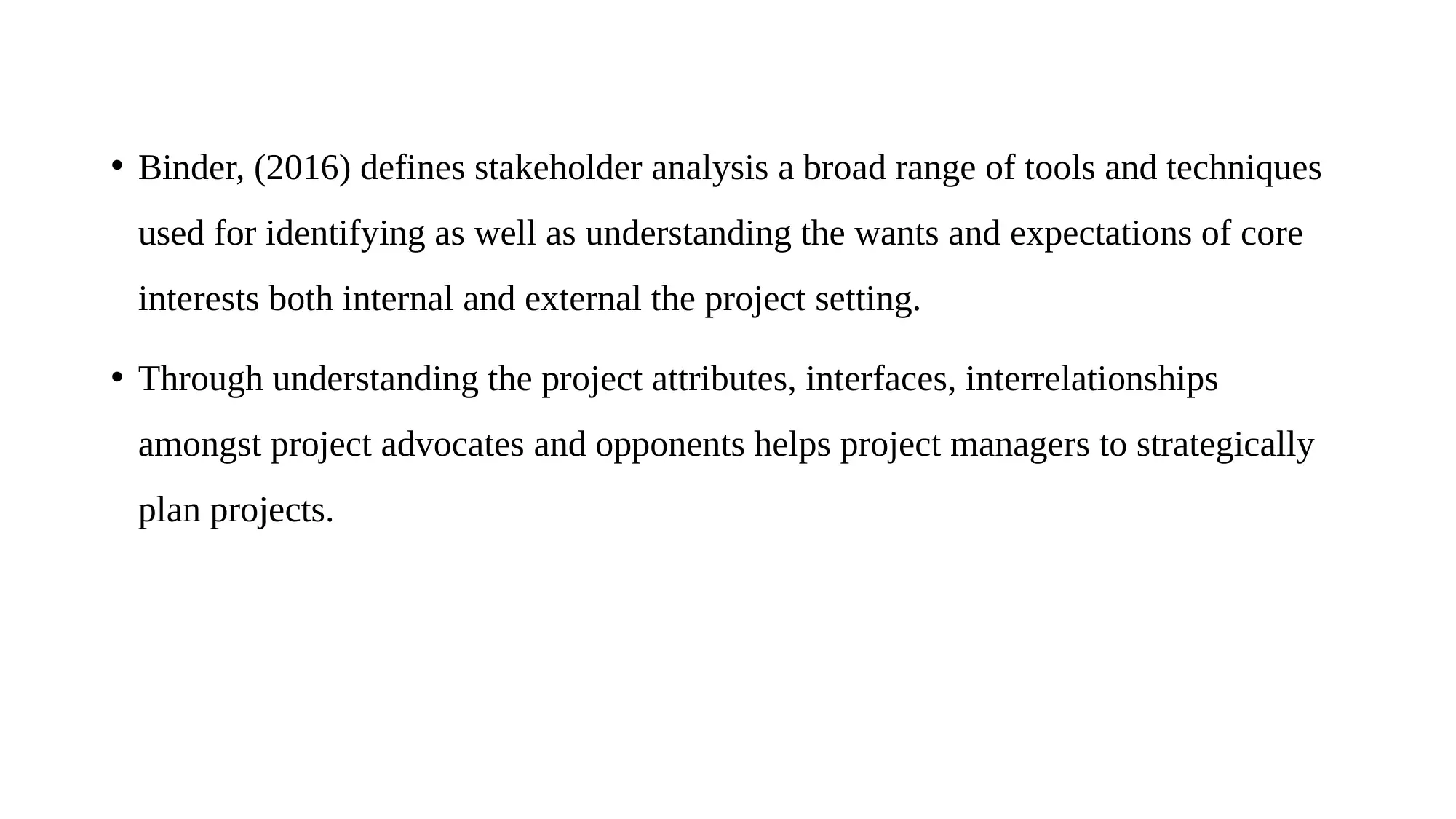
• Binder, (2016) defines stakeholder analysis a broad range of tools and techniques
used for identifying as well as understanding the wants and expectations of core
interests both internal and external the project setting.
• Through understanding the project attributes, interfaces, interrelationships
amongst project advocates and opponents helps project managers to strategically
plan projects.
used for identifying as well as understanding the wants and expectations of core
interests both internal and external the project setting.
• Through understanding the project attributes, interfaces, interrelationships
amongst project advocates and opponents helps project managers to strategically
plan projects.
Paraphrase This Document
Need a fresh take? Get an instant paraphrase of this document with our AI Paraphraser
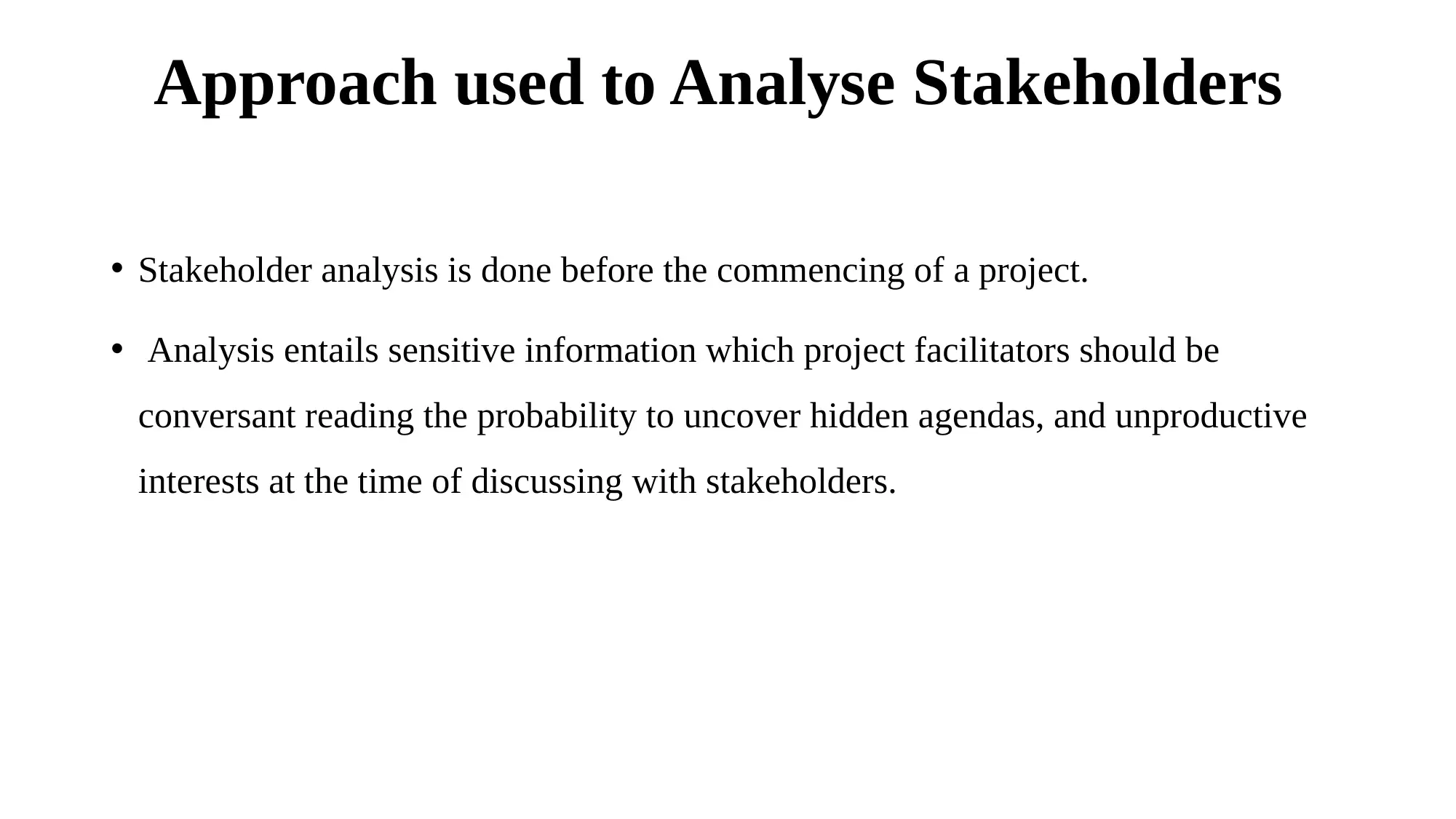
Approach used to Analyse Stakeholders
• Stakeholder analysis is done before the commencing of a project.
• Analysis entails sensitive information which project facilitators should be
conversant reading the probability to uncover hidden agendas, and unproductive
interests at the time of discussing with stakeholders.
• Stakeholder analysis is done before the commencing of a project.
• Analysis entails sensitive information which project facilitators should be
conversant reading the probability to uncover hidden agendas, and unproductive
interests at the time of discussing with stakeholders.
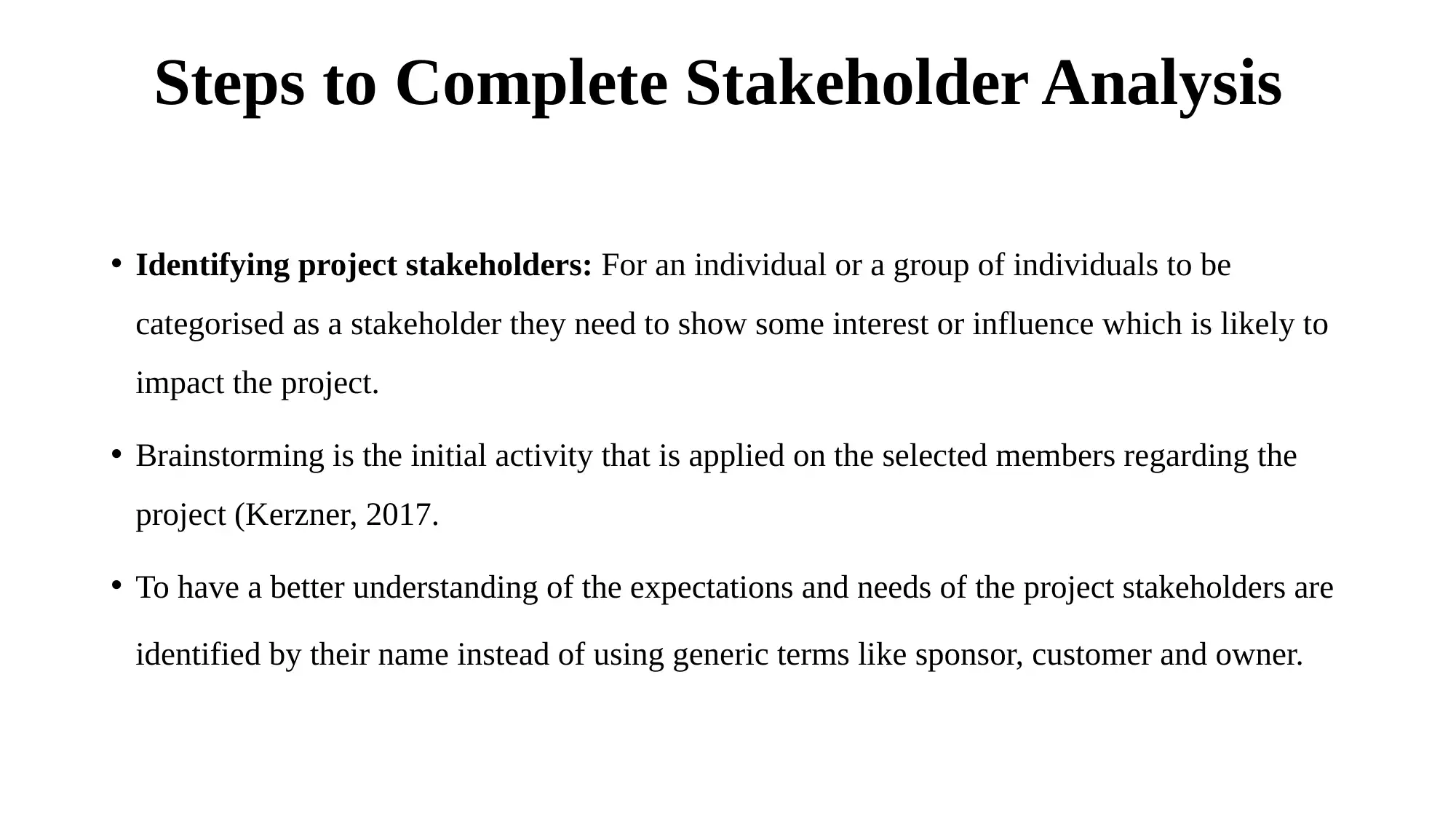
Steps to Complete Stakeholder Analysis
• Identifying project stakeholders: For an individual or a group of individuals to be
categorised as a stakeholder they need to show some interest or influence which is likely to
impact the project.
• Brainstorming is the initial activity that is applied on the selected members regarding the
project (Kerzner, 2017.
• To have a better understanding of the expectations and needs of the project stakeholders are
identified by their name instead of using generic terms like sponsor, customer and owner.
• Identifying project stakeholders: For an individual or a group of individuals to be
categorised as a stakeholder they need to show some interest or influence which is likely to
impact the project.
• Brainstorming is the initial activity that is applied on the selected members regarding the
project (Kerzner, 2017.
• To have a better understanding of the expectations and needs of the project stakeholders are
identified by their name instead of using generic terms like sponsor, customer and owner.
⊘ This is a preview!⊘
Do you want full access?
Subscribe today to unlock all pages.

Trusted by 1+ million students worldwide
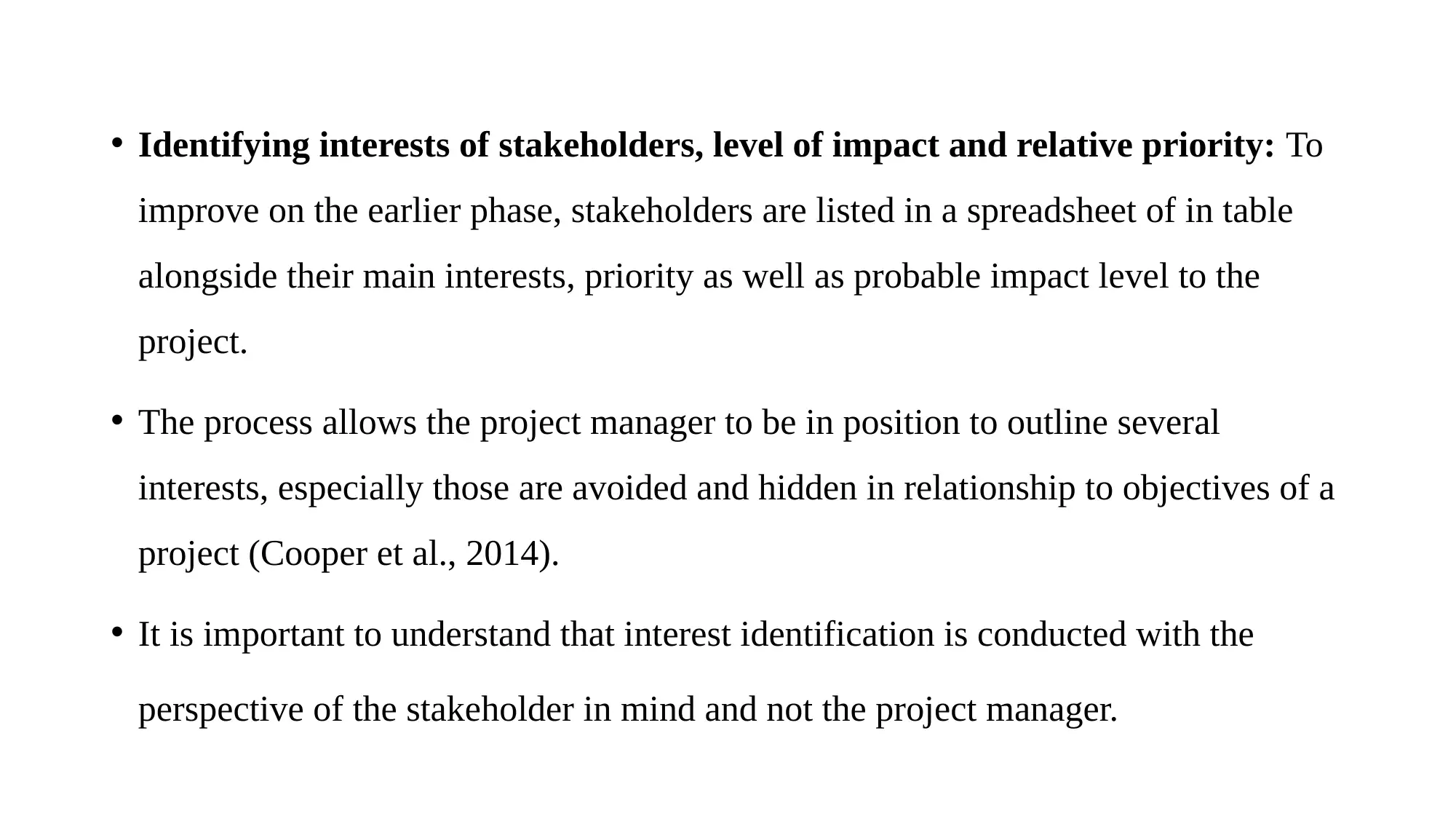
• Identifying interests of stakeholders, level of impact and relative priority: To
improve on the earlier phase, stakeholders are listed in a spreadsheet of in table
alongside their main interests, priority as well as probable impact level to the
project.
• The process allows the project manager to be in position to outline several
interests, especially those are avoided and hidden in relationship to objectives of a
project (Cooper et al., 2014).
• It is important to understand that interest identification is conducted with the
perspective of the stakeholder in mind and not the project manager.
improve on the earlier phase, stakeholders are listed in a spreadsheet of in table
alongside their main interests, priority as well as probable impact level to the
project.
• The process allows the project manager to be in position to outline several
interests, especially those are avoided and hidden in relationship to objectives of a
project (Cooper et al., 2014).
• It is important to understand that interest identification is conducted with the
perspective of the stakeholder in mind and not the project manager.
Paraphrase This Document
Need a fresh take? Get an instant paraphrase of this document with our AI Paraphraser
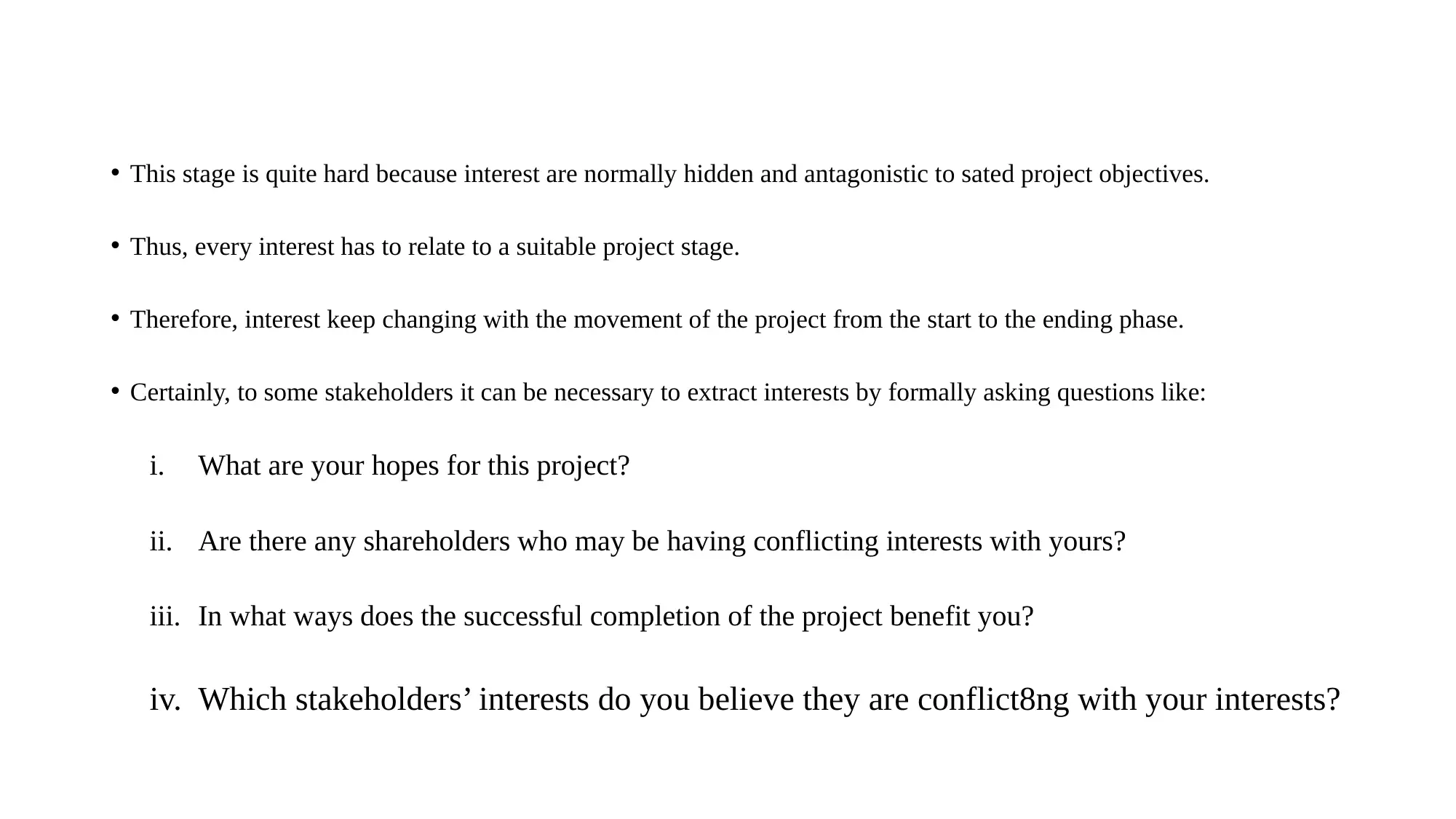
• This stage is quite hard because interest are normally hidden and antagonistic to sated project objectives.
• Thus, every interest has to relate to a suitable project stage.
• Therefore, interest keep changing with the movement of the project from the start to the ending phase.
• Certainly, to some stakeholders it can be necessary to extract interests by formally asking questions like:
i. What are your hopes for this project?
ii. Are there any shareholders who may be having conflicting interests with yours?
iii. In what ways does the successful completion of the project benefit you?
iv. Which stakeholders’ interests do you believe they are conflict8ng with your interests?
• Thus, every interest has to relate to a suitable project stage.
• Therefore, interest keep changing with the movement of the project from the start to the ending phase.
• Certainly, to some stakeholders it can be necessary to extract interests by formally asking questions like:
i. What are your hopes for this project?
ii. Are there any shareholders who may be having conflicting interests with yours?
iii. In what ways does the successful completion of the project benefit you?
iv. Which stakeholders’ interests do you believe they are conflict8ng with your interests?

• Once the key interests are recognised the project manager outlines the way in which the
project shall have to be compressed if they are not met.
• Assessing stakeholders for significance and influence: In order to understand the
understanding level of stakeholders regarding the influence and importance to the project.
• Thus, to understand this, a formal evaluation of every stakeholder’s level of influence to
the project.
• Influence shows the stakeholder’s comparative power in and within a project.
• Stakeholders with great influence help to manage major decisions within the project as
they have strong capability to contribute to the project implementation of tasks among
other actions.
project shall have to be compressed if they are not met.
• Assessing stakeholders for significance and influence: In order to understand the
understanding level of stakeholders regarding the influence and importance to the project.
• Thus, to understand this, a formal evaluation of every stakeholder’s level of influence to
the project.
• Influence shows the stakeholder’s comparative power in and within a project.
• Stakeholders with great influence help to manage major decisions within the project as
they have strong capability to contribute to the project implementation of tasks among
other actions.
⊘ This is a preview!⊘
Do you want full access?
Subscribe today to unlock all pages.

Trusted by 1+ million students worldwide
1 out of 32
Related Documents
Your All-in-One AI-Powered Toolkit for Academic Success.
+13062052269
info@desklib.com
Available 24*7 on WhatsApp / Email
![[object Object]](/_next/static/media/star-bottom.7253800d.svg)
Unlock your academic potential
Copyright © 2020–2025 A2Z Services. All Rights Reserved. Developed and managed by ZUCOL.




